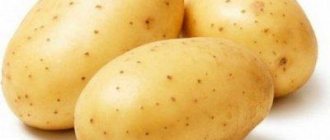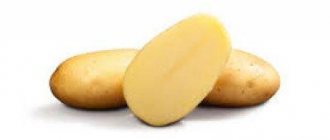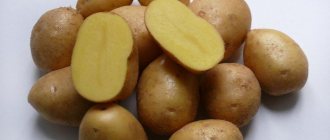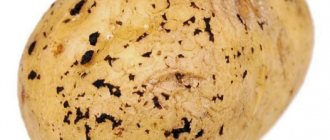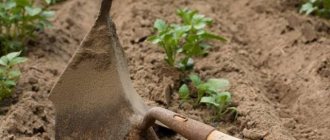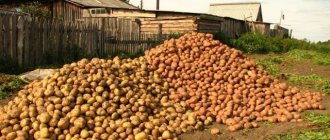Origin story
The Galaxy variety is considered a new product. The root crop was developed by Irish breeders. Initially, scientists set themselves the task of obtaining an early-ripening variety that was practically not affected by late blight. Additionally, special attention was paid to taste, as well as the possibility of long-term storage of the crop during the winter period. The crop passed varietal tests and was distributed throughout the Russian Federation.
Potato variety Gala - characteristics, description, taste, reviews
It is suitable for cultivation in open ground in the climatic conditions of Russia, Ukraine, and the Republic of Belarus. When properly grown, the crop produces from 12 to 20 medium-sized tubers per bush. Description of the Gala potato variety, photos, reviews are presented in this material.
The Gala variety is classified as an early ripening variety. It ripens 75–80 days after planting. The bushes have a spherical shape and bloom with white flowers. Stems are dense, dark green.
Medium-sized potato tubers grow up to 8 cm in length. The maximum weight of each tuber is no more than 115 g.
Root vegetables of the Gala variety are oval in shape, yellow in cross section, and have a glossy, dense skin with a waxy sheen. Ripe Gala potatoes tolerate transportation and storage well.
The Gala variety is valued by gardeners for its productivity, and by culinary specialists for its extraordinary taste. Gala is a variety of general use, as it contains little starch and is less moist. It crumbles easily under a fork. Gala is a universal variety, suitable for frying, boiling, and making French fries.
Thanks to its neat, oval, even potato tubers and low tendency to brown after peeling, Gala is an ideal variety for potato peelers. The variety is also good for storage.
Growing and care
Features of caring for potatoes of the Gala variety include several agrotechnical measures:
- soil preparation,
- landing,
- application of fertilizers,
- watering.
Growing conditions
Considering the fact that the Gala variety is not considered demanding in terms of agricultural technology, gardeners should not worry too much about creating special conditions. But to obtain a good harvest, guaranteed shelf life and beautiful presentation, the following conditions must be ensured:
- choose a well-lit place for planting, not blown by the winds;
- provide three times abundant watering when planting, flowering and ripening potatoes;
- apply fertilizer the day before planting;
- treat potato planting material with anti-disease agents;
- choose the right time to plant potatoes.
To grow the Gala potato variety in accordance with the requirements of agricultural technology, first of all, suitable growing conditions are selected. The landing site must meet the following requirements:
- flat surface, without slope, ditches or hills;
- lack of proximity to a river, reservoir and surface groundwater;
- low percentage of soil acidity.
Due to its high tuber set rate, Gala should be grown in medium to highly fertile soils. But even on poor soil, growing the variety gives good results if fertilizers are applied correctly and agricultural practices are followed.
Fertilizers
The average resistance of the plant to possible diseases, as well as the yield of the Gala variety, will increase if fertilizer is added to each hole immediately upon planting. Folk remedies are used to feed planting material:
- onion peel;
- crushed eggshells;
- wood ash.
Spring and autumn fertilizing should be carried out with fertilizers of different compositions:
- in the fall it is better to add potassium and phosphorus;
- in spring - saltpeter.
Organic fertilizers are well absorbed by the crop:
- diluted manure;
- chicken droppings (only in autumn);
- compost;
- cereal mulch.
Description and characteristics
In terms of ripening time, the Galaxy variety is considered mid-early. The crop is high-yielding and is rarely affected by nematodes and late blight. The tubers have good taste, excellent presentation, and are resistant to mechanical damage. According to its intended purpose, the Galaxy variety is considered a table variety. The advantage of Irish potatoes is their stable yield every season. Detailed characteristics of the variety are given in the table.
| Growing season | maximum 90 days |
| Starch content in pulp | from 16 to 18% |
| Tuber weight | about 90 g |
| Number of potatoes in one bush | from 12 to 14 pieces |
| Productivity per 1 ha | from 250 to 300 quintals |
| Percentage of safety in winter in the cellar | about 95% |
| Tuber skin color | white |
| Flesh color | white with a yellowish tint |
| Immunity to disease | nematode, late blight, cancer, average resistance to scab |
| Best Growing Areas | the Galaxy variety is adapted to the climatic conditions of all regions of the Russian Federation |
| Features of the variety | Standard agricultural technology is suitable for cultivation; the above-ground part does not dry out for a long time |
| Features of tubers | the pulp does not darken quickly after peeling, excellent taste |
| Purpose | tubers are used for any dishes, starch, but are best in demand when making purees |
Bushes of the Galaxy variety grow tall. The tops are powerful and do not lie on the ground. Peduncles of medium size. The corolla is bright red with a purple tint. Potato leaves are large and rich green in color. The root shape is oval. The eyes are small, painted scarlet around the perimeter.
Potato Galaxy: variety description, photos, reviews, yield, planting and care
Potato Galaxy is a variety that is adapted to unfavorable climatic conditions. The adapted crop is rarely susceptible to diseases and bears fruit well. It is gaining popularity due to the high taste and long shelf life of the tubers.
Description of the potato variety Galaxy
Irish variety - mid-early. The taste is excellent. The harvest is stable even under unfavorable conditions. Galaxy Tubers:
- beautiful presentation;
- resistant to mechanical damage;
- not susceptible to most diseases;
- starch content 16-18%;
- average weight – 90 g;
- peel white;
- the pulp is light yellow and does not darken when cut;
- round-oval shape;
- suitable for use in any dish; the flavor develops well when cooked;
- table use;
- eyes are small, color – red;
- an average of 13 pieces grow in a bush;
- When cooked, the fruits become crumbly and the puree turns out delicious.
The Galaxy variety is undemanding to climate and soil. Retains the green color of the tops for a long time. The early ripening crop is resistant to late blight. Ripens on average 90 days.
Galaxy potatoes are suitable for growing in all regions:
- RF;
- Belarus;
- Ukraine;
- Moldova.
Important! Potatoes Galaxy pleases with a bountiful harvest even with insufficiently competent care.
Description of bushes:
- erect, maximum height – 1.2 m;
- the flowers have a medium-sized corolla, the color is red-violet;
- large green leaves;
- stem thickened, ribbed;
- The tops are powerful and do not lie on the ground.
In order for the root system, which is located in the seed, to grow, the ground temperature must be at least + 10 ° C.
In order for potatoes to bear fruit abundantly, it is necessary to change the location annually. If this is not possible, then green manure should be planted in the autumn. These include grass, legumes, and winter crops. Also in autumn you can fertilize the soil with manure. For 1 m2 use 5 kg. Before frost, all weeds, debris and tops should be removed.
Characteristics of the Galaxy potato variety
Galaxy culture is resistant to cracking. Easy to transport. Not afraid of long distances. Storage time is 9 months if favorable conditions are created. The Galaxy variety has excellent drought and frost resistance.
Productivity
Potato Galaxy is a high-yielding variety. On average they harvest 27 t/ha. The bush produces about 13 tubers.
Important! If you plant the seed deeply, the crop will grow small because there will not be enough nutrients.
Landing rules
It is best to plant Galaxy potatoes in place;
- cereals;
- annual and perennial herbs;
- legumes;
- if the soil is sandy, then planting is allowed after lupine.
During digging in the spring, fertilizers are applied. They help replenish the soil with nutrients. The best landing time is the first ten days of May.
Algorithm of actions:
- Within a month, the planting material is taken out into a bright room with high humidity. The tubers should sprout.
- Sort through, discarding damaged copies.
- Treat with fungicides to prevent pests from destroying the potatoes.
- The holes must be dug in advance. To speed up growth, fill with wood ash.
- Plant in rows. The row spacing should be 60 cm. The distance from hole to hole is 40 cm.
- Place the potatoes into the soil. Depth no more than 10 cm.
To prevent the root system of trees from destroying the crop, you should choose a place to plant potatoes away from other plants.
Potato Galaxy prefers well-lit areas. There should be no drafts. Strong gusts of wind quickly spread spores of fungi and pests.
When planting tubers, it is important to maintain distance
Features of cultivation
With proper care, the Galaxy potato variety produces a bountiful harvest. Prefers loose soil and does not tolerate weeds. It reacts positively to fertilizing and receives useful elements from compost, as well as from a mixture of manure and peat. If the above-ground part is affected by night frosts, the crop must be fed with mineral fertilizer that contains nitrogen.
Basic rules of care:
- The beds are weeded, removing weeds. The soil is regularly loosened. The procedure is carried out until buds appear on the tops.
- Hilling is carried out at a stem height of 15-20 cm. Use a walk-behind tractor or a hoe. The earth is raked from both sides of the row.
- Provide regular watering. Potato Galaxy loves moist soil. During the procedure, the soil is spilled with plenty of water. The soil humidity should average 80%.
It is important to monitor the condition of the foliage. If they are being chewed by Colorado potato beetles, then the crop must be treated with pesticides.
Hilling is a mandatory process. The procedure stimulates the growth of the bush and helps improve oxygen access to the root system. Tubers are tied in the resulting tubercles.
Hilling is carried out three times:
- When the bushes reach 15-20 cm in height.
- 12 days after the first procedure.
- If rain or watering erodes the earthen hill, and the root system comes to the surface.
It is convenient to carry out hilling with a walk-behind tractor
Potato Galaxy needs to be fed:
- During top growth, if the bush grows slowly, the leaves are pale and the stems are thin. Add 500 ml of mullein slurry to a bucket of water. Apply 0.5 liters under the bush.
- In the process of buds appearing. Add 20 g of ash and the same amount of potassium to a bucket of water. Use 500 ml for the bush.
- At the time of rapid flowering, fertilizing promotes the formation of tubers. 40 g of superphosphate and 200 ml of mullein slurry are poured into a bucket of water. Mix thoroughly. Pour 0.5 liters under each bush.
Fertilizing is done after watering. The soil should be moist. This method is not suitable for large plantations. To apply fertilizer, you need to use a dry mixture, scattering it around the bushes. After this, abundant watering is performed. With proper care, the Galaxy variety will delight you with large tubers.
Pests and diseases
Most often, potatoes are affected by bacteria due to violations of growing technology. A common disease is scab. It can destroy most of the crop. Affects fruits on the surface. It spoils the appearance, impairs keeping quality and taste.
Scab spoils the skin of tubers
Galaxy potatoes are attacked by:
- Wireworm.
The larvae gnaw holes in the fruits. Wireworm attacks tubers in the second half of summer - Colorado beetle.
The pest is excessively gluttonous. In a massive attack, it destroys the entire green part. The most effective way to combat it is by hand collection. Colorado beetles spread viral diseases - The nematode damages the tubers.
The appearance is noticeable by the sharp wilting of the bushes. To prevent it, it is necessary to mechanically till the soil frequently. If the nematode is severely infested, the peel on the fruit cracks and dry rot forms in the pulp.
Pests are afraid of strong and pungent odors. For prevention, marigolds can be planted around the crop. If you add wood ash to the holes when planting, then at first it will be able to protect the Galaxy potatoes from insects.
Harvesting and storage
Harvesting begins three months after the seedlings have sprouted. You can dig with a shovel or walk-behind tractor. Store in a well-ventilated area with a humidity of 85%. The air temperature should be + 2-4 °C.
Important! Galaxy potatoes retain the taste and structure of the tubers for nine months.
Tubers remain dense until spring
Conclusion
Galaxy potatoes are suitable for growing on an industrial scale and for summer cottages. With minimal care, it produces a stable harvest in all weather conditions.
Reviews of Galaxy potato varieties
Dmitry Sokolov, 42 years old, Smolensk, bought mini tubers at the market. I planted Galaxy potatoes in a sunny area. He was able to defeat Colorado beetles with the help of pesticides. The harvest was good. The whole family liked the variety. I left small specimens for seedlings.
Inga Kholodova, 43 years old, UkhtaSort, was advised by a neighbor in her dacha. I liked the simplicity. May was cold and the summer was dry. I collected an average of 12 tubers from each bush. Weight about 90 g. I like to make mashed potatoes. Valentina Tarasenko, 65 years old,
Smolensk I have been planting Galaxy potatoes for five years. I like the variety because it is unpretentious. I planted it in the spring. I spud it once. You don’t have to constantly go to the dacha and take care of it. If beetles appear, I spray them with different preparations. We eat the harvest almost until summer.
2 Radishes
Garden online magazine
Adblock detector
Source: https://2rediski.ru/kartofel/galaktika/
Landing
Attention! Learn more about planting potatoes.
As for the Galaxy variety specifically, the crop grows best in the place of perennial and annual grasses, legumes, and grains. In sandy soil conditions, potatoes can be planted after lupine.
Attention! For Galaxy potatoes, the thickness of the arable soil layer must be maintained within 27–30 cm.
In the spring, before planting, fertilizers are applied during plowing to replenish the soil with nutrients. The optimal time for planting tubers is early May. Plant potatoes in rows. The row spacing is at least 60 cm. The distance between tubers is 35 cm. Planting potatoes are immersed to a depth of 10 cm.
About a month before planting, the tubers are taken to a bright, damp room. Here they will germinate until they sprout. It is advisable to sort through the potatoes to identify spoiled tubers.
Since autumn, many pests have hid in the ground for the winter. To prevent them from destroying the potatoes immediately after planting, the tubers are treated with fungicides.
Attention! Detailed information about processing potatoes before planting.
The hardiest and most productive Irish potato - Galaxy: description of the variety
The Irish potato variety Galaxy is characterized by early ripening, productivity, and resistance to nematodes and late blight. As a result of the tests, the crop earned high marks for its marketability and taste, and showed long-term preservation and suitability of root crops for keeping well for the winter.
| Ripening time | starch,% | Weight of tubers, gr. | Number of tubers in a bush | Productivity, c/ha | Keeping quality, % | Peel color | Flesh color | Country of selection |
| Mid-early | 16-18 | 90–100 | 12-14 | 250–300 | 95 | Yellow | White | Other |
Description and characteristics of the variety
The Galaxy potato belongs to the category of mid-early table varieties.
Harvesting is possible from July, when young potatoes are dug up. Digging for storage is carried out 75–90 days after germination.
Plants of medium height (40–50 cm). The stems are powerful and not prone to lodging or breaking. Flowering with red-violet buds.
Distinctive features of tubers:
- average weight - 90–100 g;
- starchiness above average - 16–18%;
- the color of the skin and core is white;
- texture - dense;
- pulp boilability is moderate;
- There are few ocelli (located 2 mm deep), with a reddish tint.
The commission rates the taste of the tubers 9 points out of 10. For early ripening varieties, these potatoes are well preserved in winter - keeping quality is 95%. In cooking it is used for making purees, used in soups and borscht, for roasts, stews, stews and baked dishes.
Origin story
A breeding group from Ireland participated in the creation of the variety. In Russia, the Galaxy variety is cultivated in the middle zone, in the south, in Siberia and the Urals, in Altai and the Far East. The advantage of culture is adaptation to different climatic zones.
Advantages and disadvantages
Pros:
- friendly maturation;
- possibility of mechanized processing during planting, harvesting, hilling;
- marketability and high consumer qualities;
- pleasant balanced taste;
- complex immunity (late blight, scab, nematode);
- cold resistance and drought tolerance;
- resistance to mechanical damage.
Minuses:
- the importance of preventive pest control.
Landing
Seeds are selected in the fall or ordered from an agricultural store. The material for planting should be the size of a chicken egg (length 6 cm, weight 60–70 g).
Before planting, the tubers are treated with Prestige, Intavir (protection against larvae and Colorado potato beetles). For disinfection, you can use 1% potassium permanganate, 40% formalin or boric acid. These solutions will protect against wireworms and rot.
Treatment with activators (Epin, Kornevin) will give earlier shoots. Before planting, the tubers are warmed up gradually: sudden temperature changes will reduce stability and germination.
Growing and care
Potatoes are planted in fields after pumpkin and melons, beans and peas, garlic and onions, cabbage and parsnips, herbs and grains. On sandy lands, farmers recommend lupine and phacelia as green manure.
The right time to plant
The period depends on the location of the region. In temperate latitudes, planting begins in the first days of May. In the south, start planting in mid-April. In Siberia, the Urals, and Altai, planting work begins from the 2nd–3rd decade of May. The main guidelines are warming up of the soil (11–12 degrees) and the absence of soil frosts.
Site selection and soil preparation
Potatoes do not tolerate shade, acidic soil, or waterlogging. Place the plots in open areas. Light loams, loose sandy loams, transitional and combined soils are suitable.
In the fall, clear the garden bed of weeds. Plow mechanized to a depth of 27–30 cm. At the same time, apply fertilizers: compost (1 bucket per 1 sq. m), superphosphate (30 g per 1 sq. m), potassium salt (15 g per 1 sq. m). If the pH is acidic, improve the quality of the soil with dolomite and lime.
Preparing tubers for planting
Germinate seeds 30 days before planting. Sort the tubers, leaving them whole, without flaws or stains. Place the potatoes in a layer (in a mound of 2-3 pieces) on the floor in the utility room. Maintain a temperature range of 14–15°. A quick method of germination is 1–1.5 kg bags of tubers, which are kept in indirect sunlight. The length of the sprouts on the eve of planting should be 1–2 cm.
Planting pattern and depth
For potatoes, form even rows. The step between holes is 30–35 cm, the distance between rows is 60 cm. The depth of the planting depends on the type of soil: in light sandy soils, plant 10–12 cm deep, in heavy soil the optimal depth is 5–8 cm.
Further care includes hilling when the shoots grow 15 cm, and then after 3-4 weeks. Loosening is necessary after rains or watering. The frequency of the procedure is 1 time every 10 days. Excessive watering is undesirable: during moderate precipitation, potatoes are not irrigated additionally.
Care
The Galaxy variety will bring a harvest even to a lazy vegetable grower, but with good care it will show the best results. The culture loves loose soil and a complete absence of weeds. Basic care for the variety requires compliance with the following rules:
- Fertilizer for feeding the Galaxy variety should be in an easily digestible form. The plant absorbs nutrients well from all types of compost, a slurry mixture of peat and manure.
- In case of freezing of the above-ground part by spring return frosts, the bushes are fed with mineral fertilizer containing nitrogen.
- After 100% of the seedlings appear, the row spacing is constantly weeded and the soil is loosened. The procedure is carried out until buds appear on the tops.
- When the stems reach a height of 20 cm, the Galaxy potatoes are hilled up. Use a hoe or walk-behind tractor to rake up the soil on both sides of the row.
- The variety loves moist soil. During watering, bring the soil to a moisture content of at least 70% - maximum 85%.
When growing the Galaxy variety, the condition of the tops is monitored. If the Colorado potato beetle begins to chew on the leaves, the plantation is sprayed with pesticides.
The video shows the process of growing potatoes:
Agricultural technology for planting potatoes
Growing potatoes is a simple process. If you adhere to certain planting rules, you can easily obtain high yields.
Site selection and soil preparation
In order for the roots located on the tubers to grow, the soil temperature must be at least +10°C. On sandy soils, potatoes are planted to a depth of 20 cm, on heavy soils - 15 cm.
To plant potatoes, you need to choose a spacious area with good lighting and no draft, which will contribute to the spread of pests and fungal spores in the wind. The depth of groundwater in the area must be at least 1.5 m so that excess moisture does not interfere with the development of root crops.
If it is not possible to change the planting site every year, in the autumn after harvesting, the area is sown with green manure plants, such as legumes, grass, winter crops, cucumbers; they are the best predecessors for sowing potatoes.
In temperate regions, it is more advisable to use winter crops or grass, because cucumbers will not have time to ripen; you can also simply fertilize the soil with manure in the autumn. Preparing the soil for planting begins in the fall. If it is possible to change the location of the potato planting, it will be better. It is necessary to remove all weeds, remnants of tops and other debris from the site.
The soil is dug up to a depth of 30–40 cm, while fertilizers are applied in the form of manure in an amount of 5 kg per m², and 300 g of wood ash per m² is also added, which will help eliminate soil acidity and also protect future plantings from pests.
Preparing tubers for planting
Medium-sized tubers are selected for planting; they must be free of rot and diaper rash. 2 weeks before the intended planting, seed potatoes are placed in a plastic bag in which several holes are made for air intake. Potatoes with grown roots from 3 to 5 cm are suitable for planting; they must be powerful and strong.
Immediately before planting, the tubers are immersed in a slightly pink solution of manganese for 40 minutes to disinfect.
Planting pattern and depth
In the spring, a month before planting, you need to dig up the soil. Scheme for planting potatoes in the ground: 70 cm between rows and 40 cm between bushes. This planting scheme will make it easy to care for plants and will also promote the growth of tubers.
The holes are dug to a depth of 20 cm, and 100 g of chicken manure is placed at the bottom as fertilizer. Then they lay out the planting material and bury it with earth, forming a small mound on top.
Hilling and feeding
The Galaxy variety, like any other potato, cannot do without hilling. The process stimulates the growth of the bush by removing weeds and improving oxygen access to the roots. Tubers set and grow inside the earthen tubercles. During the season, two mandatory hillings are carried out and a third, if necessary. The first procedure is performed after the tops have grown to a height of about 15 cm. The second hilling of Galaxy potato bushes is done 12 days after the first procedure.
Advice! The need for a third hilling arises when earth mounds are washed away by rain or watering and potato roots appear on the surface.
The Galaxy variety responds well to fertilizing. The first fertilizer is poured into the holes when planting the tubers.
Attention! Read more about how to fertilize potatoes when planting in a hole.
During the growing season, Galaxy potatoes are fed three times at the root:
- At the initial stage of tops growth. The Galaxy variety needs feeding if the bushes grow slowly, the stems are thin and weak, and the leaf blade is pale in color. Usually two recipes are used: 10 liters of water/1 tbsp. l. urea or 10 liters of water/0.5 liters of mullein slurry. The prepared solution in a volume of 0.5 liters is poured under the bush.
- During the formation of buds. Fertilizing potatoes of the Galaxy variety is needed to accelerate the appearance of flower stalks. The solution is prepared from 10 liters of water, 1 tbsp. l. potassium and 1 tbsp. l. ash. If there is no potassium sulfate, add 1 cup of ash to the same amount of water. 0.5 liters of the prepared solution is poured under each bush.
- During vigorous flowering. The third feeding of the Galaxy variety promotes tuber setting. The solution is prepared from 10 liters of water, 2 tbsp. l. superphosphate and 1 cup mullein slurry. Under each bush, 0.5 liters of the prepared solution is similarly poured.
Fertilizing under the root of the Galaxy potato is carried out after watering or precipitation, when the ground is still wet. The method is suitable for owners of a small plot. If the garden is large, it is difficult to water each potato bush. For application, dry mixtures are used, applying them by scattering under the bushes.
The composition for three dressings per 1 bush is as follows:
- 0.5 tsp. urea/200 g dry manure;
- 1 tbsp. l. ash/0.5 tsp. potassium;
- 1 tsp. superphosphate.
After applying dry fertilizers, the potato plantation is watered.
Cultivation care
Growing potatoes is a fairly simple process. Potatoes do not require constant weeding, constant watering or fertilizers.
Irrigation
Potato Galaxy is excellent at watering. However, potatoes should be watered sparingly, as this is a rather specific crop.
Experts advise irrigating potatoes no more than 3-4 times per season. Ideally, the following watering scheme will be followed:
- The first watering is carried out after the sprouts of the tops have gained 10-15 cm in height. Earlier watering is not recommended.
- The second watering is carried out before or during the beginning of flowering of the tops.
- And the third irrigation is carried out before the end of flowering, when the crop ends the main phase of the growing season.
Irrigation after flowering is not recommended, as there is a high probability of contracting a fungus such as late blight.
Hilling
This procedure performs several functions:
- Keeps the tops from sticking to the soil.
- Saturates the soil with oxygen.
- Clears the area of grass.
In addition, when hilling, the yield increases significantly.
Hill up Galaxy potatoes 2 times during the growing season. The first time is when the tops reach 20-25 cm. The second time is about 2-3 weeks later.
Fertilizers
As noted earlier, the main soil fertilizing is carried out in the fall, after the harvest has been harvested. You can also feed the tubers directly during planting by adding humus or wood ash to the hole.
Diseases and pests
Potato diseases occur as a result of bacterial growth. Often the person himself is to blame for violating the cultivation and care technology. Most diseases are difficult, almost impossible, to cure.
Attention! More detailed information about existing potato diseases and control methods.
Scab is considered a common disease. Some gardeners ignore this disease, considering it less dangerous. This is fundamentally wrong. Scab can destroy a lot of crops.
Attention! About methods of combating scab.
Among the pests that like to feast on potatoes are the Colorado potato beetle, wireworm, and nematode. The first problem is easier to identify. When the Colorado potato beetle appears on the tops or yellow larvae, the potato plantation is sprayed with chemicals. Nematodes and wireworms eat the tubers. The appearance of the pest can be recognized by the withering bushes. The development of parasites can be prevented by frequent mechanical tillage of the soil. When the first symptoms appear, chemicals are used.
Features of planting and growing
The procedure for planting and growing is not much different from other varieties. But there are some peculiarities.
Preparation
Potato seeds for planting are prepared approximately 4-6 weeks in advance. First, they are kept in the sun for 7-8 days. At this time, poisonous solanine is formed in the seeds, which promotes better resistance to diseases and pests.
The potatoes are then placed in boxes or containers and placed in a warm, dark place to germinate. After about 3-4 weeks, sprouts appear.
Before planting, seeds are soaked in a solution of potassium permanganate for disinfection. You can also treat seed potatoes with a growth stimulator.
Planting scheme and technology
It is preferable to plant Jelly potatoes in areas where the snow melts first.
For potatoes, it is better to select places where beets, cabbage, cucumbers or greens used to grow.
The planting pattern is traditional. The procedure is as follows:
- Dig holes or furrows 8-12 cm deep.
- A little humus and ash are added to each hole, as well as onion peels to repel pests.
- Fresh manure should not be used to fertilize holes. It contains fungal spores and plant seeds, so the potatoes will hurt and lose their taste. But you can use Kemira - a complex fertilizer.
- The seeds are placed at a distance of 40 cm from each other, since the bushes grow powerful and need a lot of space. Leave about 80 cm between rows.
Features of cultivation
Potato plantings need to be harrowed in the first days, even if there are no shoots. This way weeds are destroyed and they hatch faster.
After the first shoots appear, the soil around them is loosened to remove the crust that has formed. This enriches the soil with oxygen, which is necessary for the development of the potato root system.
If planted early, frost may occur. But you can protect the seedlings by hilling up young shoots. Don't be afraid to cover them with soil, this way they will be better protected from the cold.
To save the plantings from drought and waterlogging, the soil is covered with mulch. And proper planting of green manure between rows of potatoes makes caring for the crop much easier. Mustard repels wireworms, and phacelia supplies the roots with the necessary nutrition.
To obtain a good harvest, loosening and hilling the soil around the potatoes is important. This provides the roots with oxygen and helps get rid of weeds.
Nuances of care
The Jelly variety is unpretentious; basic agrotechnical procedures are enough for it.
Watering mode
Water the potatoes systematically according to the following scheme:
- Do not water until the tops appear.
- Water for the first time when the bush is 10-25 cm high.
- The second time is when buds begin to form.
- Water the third time before the end of flowering.
In a very dry region or in very hot and dry summers, the amount of watering can be increased, but stopped after flowering has ended.
Top dressing
During the growing season, Jelly potatoes are fed three times:
- at the beginning – with nitrogen fertilizers;
- when buds and flowers appear, use fertilizers with potassium;
- during the formation of tubers - phosphorus compounds;
Disease and pest control
The variety has good resistance to many potato diseases. Jelly is not affected by:
- potato cancer;
- rhizoctoniasis;
- common scab;
- blackleg;
- viral diseases.
The only disease that affects Jelly potatoes is late blight. The disease most often develops in waterlogged soil.
If signs of disease appear (spots on the leaves), the plant must be treated with Arcedil, Ridomil MC, Oksikhom, copper oxychloride or Kuproxat.
As for pests, Jelly is resistant to the golden nematode, but is attacked by the Colorado potato beetle and wireworm. You can get rid of them with the help of chemicals, which are used strictly according to the instructions. “Bankol” or “Aktara” are suitable for fighting the beetle.
- defeat of Jelly potatoes by late blight;
- the need for frequent loosening and hilling of plantings;
- intolerance of tubers even to minor mechanical damage.
Harvesting
Three months after planting, the Galaxy potato tubers will be ready for harvest. However, the exact date varies for each region due to weather conditions. Potato tubers are dug up using a shovel or mechanical means, such as a walk-behind tractor. For winter storage, use an equipped vegetable storage facility with good ventilation, humidity of about 85% and air temperature of 3°C.
Advantages and disadvantages
The undeniable advantages of Irish potatoes "Galaxy" include:
- Adaptability to different climates.
- Resistance to bacterial and viral diseases.
- High degree of marketability of tubers.
- No browning of potatoes for a long time after peeling.
- Stable yield.
Among the disadvantages it is worth noting:
- Susceptibility to scab.
- The tops are not dry enough for the time of harvesting the tubers, which makes them difficult to dig up.
